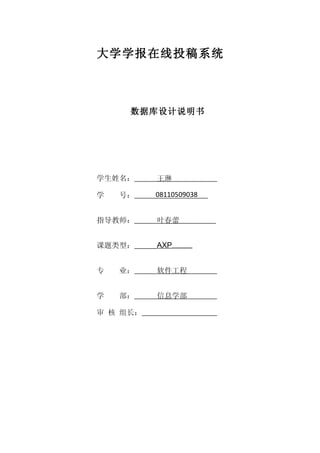
数据库设计说明书(1)王琳
- 1. 大学学报在线投稿系统 数据库设计说明书 学生姓名: 王琳 学 号: 08110509038 指导教师: 叶春蕾 课题类型: AXP 专 业: 软件工程 学 部: 信息学部 审 核 组长:
- 2. 北京城市学院 2011 年 11 月 13 日 修订历史录 日期 版本 说明 作者 1.0 未评审 王琳
- 3. 指导教师签字: 年 月 日 目录 1 引言............................................................................................................................................. 4 1.1 编写目的..........................................................................................................................4 1.2 背景..................................................................................................................................4 1.3 定义..................................................................................................................................5 2 外部设计.....................................................................................................................................5 2.1 标识符和状态..................................................................................................................5 2.2 约定..................................................................................................................................5 2.3 专门指导..........................................................................................................................5 3 结构设计.....................................................................................................................................6 3.1 E-R 图................................................................................................................................6 3.2 逻辑设计结构..................................................................................................................7 3.3 物理设计结构..................................................................................................................8 4 运用设计...................................................................................................................................10 4.1 数据字典设计................................................................................................................10
- 4. 1 引言 1.1 编写目的 《大学学报在线投稿系统数据要求说明书》目的是明确《大学学报在线投稿系 统》中各项功能和非功能性需求实现时所需要的数据,并可以此数据为根据 设计数据库。同时为概要设计和详细设计人员提供设计依据,其他本项目组 的开发人员也可参阅。 《大学学报在线投稿系统数据需求说明书》的阅读对象为: 1)对相关业务技术和总体方案作出决策的管理人员和质量管理人员 2)对本《数据需求说明书》进行评审和确认的有关业务、技术人员 3)参加数据库设计,测试设计阶段工作的全体设计人员 4)《在线投稿系统》项目组,其他有权需要调用本文档的人员 1.2 背景 开发软件名称:大学学报在线投稿系统 项目任务提出者:叶春蕾 项目开发者:王琳 用户:学校报刊杂志社 实现软件单位:北京城市学院 本系统采用 B/S,服务器端采用 Microsoft Windows XP 为操作系统的工作站, 是采用 mysql 的为开发软件的数据库服务程序。
- 5. 1.3 定义 SQL:结构化查询语言,关系数据库查询的标准语言; SQL SERVER 2005:微软公司生产的 SQL SERVER 数据库管理系统; 2 外部设计 2.1 标识符和状态 本系统采用 Microsoft Windows XP 为基本开发系统,数据库名称为 BS。数据库 中共建立五张表,分别为 UT 用户类型表,User 用户表,Type 稿件类型表,Text 稿 件信息表,Infor 留言信息表。 2.2 约定 本系统采用 Microsoft Windows XP 为基本开发平台,使用 Mysql 数据库,因而 程序员或系统分析员,或任何想要使用此数据库进行操作的人员,需要安装 Mysql 数据库,并建立相同数据库,或者可以进行联机访问,这需要安装插 件。 2.3 专门指导 对于从事此数据库的生成,此数据库的测试,维护的人员,提出如下参考意见: 数据库的输入统一使用键盘输入。由于现在没有设置权限,故只要不违背基
- 6. 本的限制,所有的操作都是可以进行的。可是对于本系统需要的数据,却是有 数据长度的限制的,尤其是有说明的部分,所以测试人员在具体进行数据测 试时,要注意数据输入格式。 3 结构设计 3.1 E-R 图
- 7. 账号 编号 作 关键 密码 名 类型 真实姓 Emai 摘 名 l 标 用户权 投稿用户 发 稿件 限 表 稿件名 性 收信 称 别 人 学校 状态 内容 留言 审稿 意见 审 时间 用户编号 发 发信 Email 管理员 管 审稿用户 个人简介 用户 密码 密 Emai 用户 l 图 1-1 E-R 图 3.2 逻辑设计结构 将上面的 E-R 图进行分析后,形成如下的逻辑关系结构(由于字段信息较多, 没有一一列举出来,下面只给出了各个表及其主键和外键,还有表之间的参 照关系,箭头指向的表为被参照表):
- 8. Text 稿件信息表 User 用户信息表 PK :信息 id PK :用户 id FK :类型 id FK :类型 id Type 稿件类型表 UT 用户类型表 PK :类型 id PK :类型 id 3.3 物理设计结构 表 1-1 用户类型表 字段名 数据类型 是否为空 是否主键 是否外键 含义 UT_id Number(10) no Yes no 类型编号 UT_name Varchar(20) no no no 类型名称 表 1-2 投稿用户信息表 字段名 数据类型 是否为空 是否主键 是否外键 含义 U1_id Varchar(20) no Yes no 账号名称 Truename Varchar(20) no No no 真实姓名 Password Varchar(20) no No no 密码 School Varchar(20) yes No no 学校 Email Varchar(20) yes No no 电子邮件 Phone Number(20) yes No no 电话号码 Power Varchar(10) no No yes 用户权限
- 9. 表 1-3 审稿用户信息表 字段名 数据类型 是否为空 是否主键 是否外键 含义 S_no Number(10) no Yes no 编号 S_name Varchar(20) no No no 审稿者 名称 Email Varchar(20) Yes No no 电子邮箱 S_info Varchar(100 Yes No no 个人简介 ) 表 1-4 管理员信息表 字段名 数据类型 是否为空 是否主键 是否外键 含义 Admin_name Varchar(20) no Yes no 姓名 Admin_pass Varchar(30) no no no 密码 Admin_Email Varchar(30) Yes no no 电子邮箱 表 1-5 稿件类型表 字段名 数据类型 是否为空 是否主键 是否外键 含义 Type_id Number(10) no Yes no 类型编号 Type_name Varchar(20) no no no 类型名称 表 1-6 稿件信息表 字段名 数据类型 是否为空 是否主键 是否外键 含义 Type Varchar(20) no no yes 稿件类型 No Number(20) no Yes no 稿件编号 Writer Varchar(30) no No no 作者 Keyword Varchar(50) no No no 关键字 Intro Varchar(90) no No no 摘要 Time Varchar(30) no no no 发表时间 Title Varchar(30) no No no 标题 Name Varchar(200) no No no 稿件名称 State Varchar(10) no No no 状态 Mcomment Varchar(10) no No no 审稿意见 Teacher Varchar(20) Yes No Yes 审稿人
- 10. 表 1-7 留言表 字段名 数据类型 是否为空 是否主键 是否外键 含义 Infor_id Number(10) no Yes no 留言编号 no no no 收信人 senter Varchar(30) no no no 发信人 content Varchar(3000) yes no no 内容 Infor_time Varchar(20) no no no 时间 表 1-8 通告表 字段名 数据类型 是否为空 是否主键 是否外键 含义 T_id Number(10) no Yes no 编号 Test Varchar(3000) no no no 内容 T_time Varchar(20) no no no 时间 T_infor Varchar(30) Yes no no 发告人 4 运用设计 4.1 数据字典设计 数据项描述: 系统名:大学学报在线投稿系统 系统名:大学学报在线投稿系统 数据项名称:用户 id 数据项名称:登录密码 编号:U_id 编号:pwd 简述:唯一的标识用户的账号 简述:用户登录本系统的密码 数据类型和长度:整型,20 数据类型和长度:Varchar,30 组成:用户 id={整数} 组成:登录密码={英文字母}+{数字} 系统名:大学学报在线投稿系统 系统名:大学学报在线投稿系统 数据项名称:内容 数据项名称:留言 编号:content 编号:标识列 简述:留言或回复 数据类型和长度:Varchar,3000 编号:ZT,HY,GN 组成:内容={汉字}+{英文}+{数字}+{符号} 简述:用以唯一描述信息的字段 数据类型和长度:Int,10
- 11. 数据流描述: 系统名:大学学报在线投稿系统 系统名:大学学报在线投稿系统 数据流名称:用户登录 数据流名称:发表文章 简述:用户登录系统时的必经过程 简述:用户在系统中发表自己的文章 数据流来源:用户 数据流来源:用户 数据流去处:数据处理用户信息 数据流去处:数据存储“Test 稿件信息表 数据流组成:用户登录=用户 id+登录密码 ” 数据流组成:发表文章=作者+关键字+摘 要+标题+稿件名称+发表时间 系统名:大学学报在线投稿系统 系统名:大学学报在线投稿系统 数据流名称:修改文章 数据流名称:上传文章 简述:用户在系统中修改自己的文章 简述:用户在系统中上传自己的文章 数据流来源:数据处理“Test 稿件信息表 数据流来源:用户 ” 数据流去处:数据存储“Test 稿件信息表 数据流去处:数据存储“Test 稿件信息表 ” ” 数据流组成:上传文章=文章 id+文章名称 数据流组成:修改文章=作者+关键字+摘 +上传时间+存储路径 要+标题+稿件名称+最新时间 系统名:大学学报在线投稿系统 系统名:大学学报在线投稿系统 数据流名称:审核文章 数据流名称:发表留言 简述:用户在系统中审核文章 简述:用户在系统中给系统或审稿者留言 数据流来源:数据处理“Test 稿件信息表 数据流来源:用户 ” 数据流去处:数据存储“Infor 留言表” 数据流去处:数据存储“Test 稿件信息表 数据流组成:发表留言=收信人+内容+发 ” 信人+时间 数据流组成:审核文章=作者+关键字+摘 要+标题+稿件名称+最新时间+文章内容 系统名:大学学报在线投稿系统 系统名:大学学报在线投稿系统 数据流名称:修改个人信息 数据流名称:修改密码 简述:用户在系统中修改自己的信息 简述:用户在系统中修改自己的密码 数据流来源:数据处理“User 用户信息表 数据流来源:数据处理“User 用户信息表 ” ” 数据流去处:数据存储“User 用户信息表 数据流去处:数据存储“User 用户信息表 ” ” 数据流组成:修改个人信息=账号名 数据流组成:修改密码=用户名+密码 +Email+学校